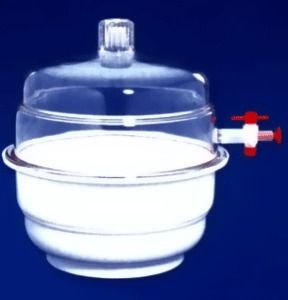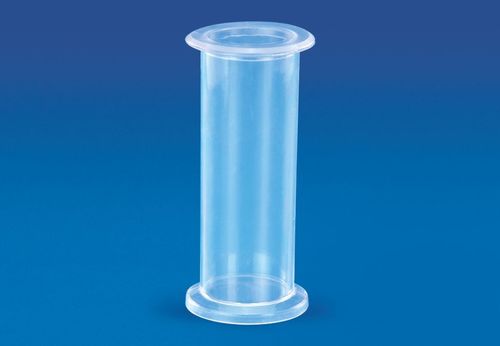DESICCATOR (PLAIN)
DESICCATOR (PLAIN) Specification
- Shape
- Cylindrical
- Power Supply
- Not required
- Temperature Resistance
- Up to 300C
- Glass Type
- Borosilicate Glass
- Control Type
- Manual lid placement
- Features
- Airtight design, removable porcelain plate, chemical resistant, visible contents
- Type
- Plain Desiccator
- Dimension (L*W*H)
- Approx. 150 mm, 200 mm, 250 mm (Diameter options)
- Equipment Type
- Laboratory Glassware
- Equipment Materials
- Borosilicate Glass, Porcelain Plate
- Material
- Transparent borosilicate glass body, porcelain plate
- Application
- For safe storage and moisture removal from laboratory samples
- Capacity (Ltr)
- Varies by diameter; typical sizes are 1.5L, 4L, 7L
About DESICCATOR (PLAIN)
| DESICCATOR (PLAIN) | |||||||||||||||
| Plain Desiccators are physically the same as vacuum desiccator. Only difference is the absence of stop cock. Grease should be applied on the flanges to make it air tight.
|
Airtight Storage for Sensitive Samples
This desiccator provides a secure, moisture-free environment for laboratory samples. Thanks to the precision-ground glass lid seal and removable porcelain plate, desiccants can be placed efficiently, safeguarding against humidity. Its airtight design keeps even the most sensitive chemicals stable over time.
Superior Chemical and Thermal Resistance
Constructed from borosilicate glass and porcelain, the desiccator delivers robust resistance against acids, alkalis, and solvents. Additionally, it is engineered to tolerate temperatures up to 300C, making it suitable for numerous laboratory protocols and storage requirements.
Versatile and Easy to Use in the Lab
With its simple knob top and removable plate, the plain desiccator offers straightforward manual operationno power needed. Compatible with various desiccants, it is ideal for routine sample preparation, drying processes, and secure substance storage in laboratories.
FAQs of DESICCATOR (PLAIN):
Q: How does the ground glass edge ensure an airtight seal in this desiccator?
A: The ground glass edge on both the body and lid provides a precision fit, creating an airtight closure when the lid is placed. This prevents moisture from entering and helps maintain a controlled, dry atmosphere inside the desiccator.Q: What types of desiccants can be used with the porcelain plate?
A: This desiccator is compatible with silica gel, anhydrous calcium chloride, and other laboratory desiccants. The porcelain plate serves as a support, keeping desiccants separated from the stored items while allowing effective moisture absorption.Q: When is it recommended to use a plain desiccator in the laboratory?
A: A plain desiccator is ideal when you need to store moisture-sensitive samples, dry glassware, or protect chemicals from humidity. It is also routinely used after sample heating or washing to maintain dryness during cooling or storage.Q: Where should this desiccator be placed for optimal performance?
A: For best results, position the desiccator on a stable, flat laboratory surface, away from direct sunlight and heat sources. This ensures even sealing, stability, and prevents thermal stress on the glass.Q: What is the process for adding or replacing desiccant in the desiccator?
A: To replace the desiccant, remove the lid using the knob top, carefully lift out the porcelain plate, and swap in fresh desiccant. Reinsert the plate and close the lid to restore the airtight seal. Always ensure hands and equipment are dry during this process.Q: How does the borosilicate glass construction benefit laboratory use?
A: Borosilicate glass is valued for its high resistance to chemical corrosion and thermal shock. This makes the desiccator safe for storing aggressive chemicals and for use with temperature changes up to 300C, ensuring durability and reliability.Q: What are the main advantages of using this plain desiccator over other moisture control options?
A: Key benefits include its airtight, manual design, visible contents for easy monitoring, broad chemical compatibility, and robust temperature resistance. It does not require power, making it a practical and dependable choice for laboratory moisture control.

Price:
- 50
- 100
- 200
- 250
- 500
- 1000+
More Products in POLYLAB PLASTICWARE Category
DESICCATOR (VACUUM)
Equipment Materials : Plastic & Glass
Shape : Circular
Temperature Resistance : Up to 120C (approx.)
Dimension (L*W*H) : As per standard laboratory sizes
Type : Other, Vacuum Desiccator
Material : Plastic & Glass
L SHAPED SPREADER
Equipment Materials : Laboratory Grade Plastic
Shape : L Shaped
Temperature Resistance : Autoclavable up to 121C
Dimension (L*W*H) : Approx. 150 x 20 x 3 mm
Type : Other, L Shaped Spreader
Material : Polypropylene (PP)
SPECIMEN JAR (GAS JAR)
Equipment Materials : Glass
Shape : Cylindrical
Temperature Resistance : Up to 300C (approx., depends on glass quality)
Dimension (L*W*H) : Varies; commonly available in sizes like 150mm x 65mm, 200mm x 75mm, etc.
Type : Other, Specimen Jar (Gas Jar)
Material : Borosilicate Glass
RACK FOR SCINTILLATION VIAL
Equipment Materials : Acrylic, Polypropylene
Shape : Rectangular
Temperature Resistance : Up to 100C depending on material
Dimension (L*W*H) : 240 mm x 70 mm x 40 mm
Type : Other, Scintillation Vial Rack
Material : Rigid plastic (Polypropylene or Acrylic)
GST : 06ACOPS0805K1ZD
|
 |
SINGHLA SCIENTIFIC INDUSTRIES
All Rights Reserved.(Terms of Use) Developed and Managed by Infocom Network Private Limited. |


 Send Inquiry
Send Inquiry





